A supergiant star exploded as a supernova in the prominent galaxy M101 in Ursa Major. It’s now bright enough to see in a 4.5-inch telescope!
Updates:
The Gemini North Telescope, which just came online again after a refurbishment of its primary mirror, has obtained a stunning image of the supernova:
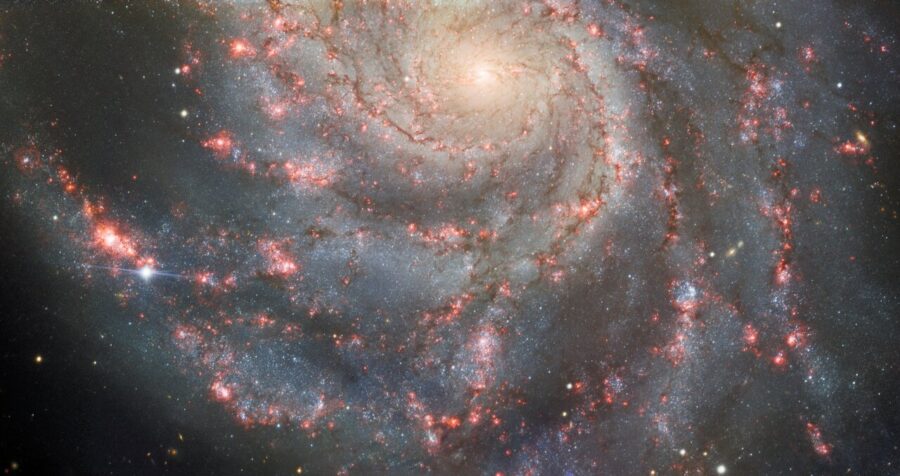
International Gemini Observatory / NOIRLab / NSF / AURA Image Processing: J. Miller (Gemini Observatory/NSF’s NOIRLab), M. Rodriguez (Gemini Observatory/NSF’s NOIRLab), M. Zamani (NSF’s NOIRLab), T.A. Rector (University of Alaska Anchorage/NSF’s NOIRLab) & D. de Martin (NSF’s NOIRLab)
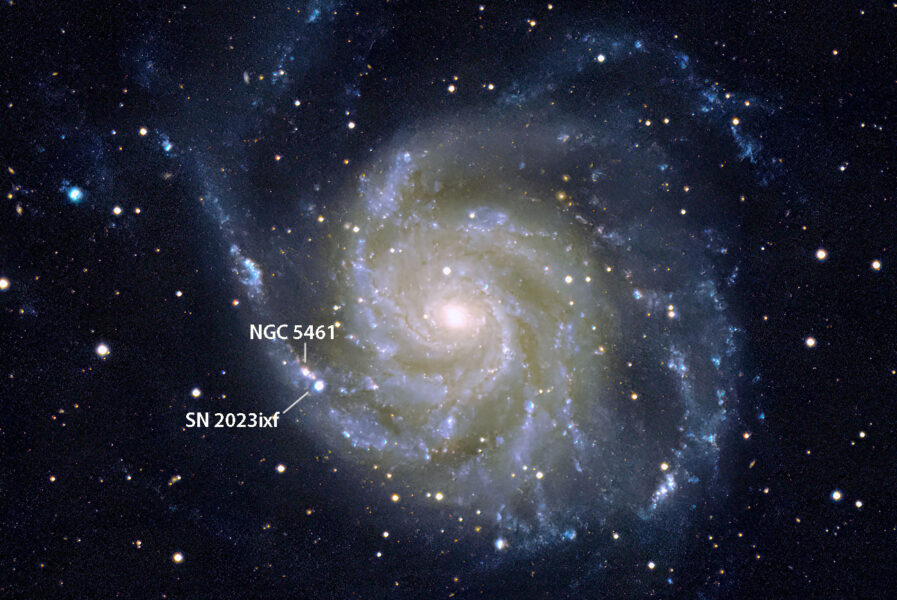
Eliot Herman
I heard the news about a magnitude-14.9 supernova in the galaxy M101 in Ursa Major on Friday evening, May 19th. That same night, a major auroral display lit up the sky here in northern Minnesota. Although the lights were spectacular, I couldn't wait to get my eyes on the new star. As soon as the aurora faded back, I set the telescope up for a look.
Never mind 14.9. The star had skyrocketed to magnitude 13.5 just 11 hours after discovery. It continues to rise. As of Sunday night, May 21st, it had climbed to magnitude 11.1 and showed no signs of stopping. In the space of a weekend, the supernova became within reach of a 4.5-inch telescope!
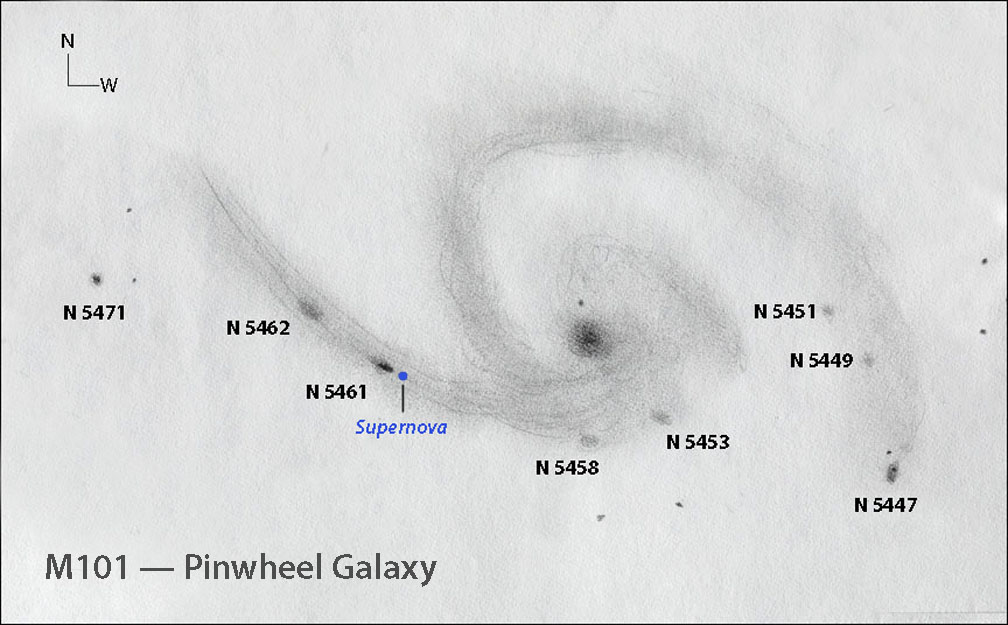
Bob King
Superstar supernova hunter Koichi Itagaki discovered the new object, designated SN 2023 ixf, on May 19.7 UT, immediately southwest of the prominent HII region NGC 5461. The pair contrast splendidly in one of the galaxy's outer spiral arms.
At 245× in my 15-inch Dob, NGC 5641 is a small, slightly elongated puff with a distinct, near-stellar core. A 2004 study with the Hubble Space Telescope revealed it holds three massive, young star clusters similar to the colossal stellar nursery R136 located in the Tarantula Nebula in the Large Magellanic Cloud. Supergiants are frequently found within large clusters that knot galactic spiral arms. Might this one have a connection to its fertile neighbor?
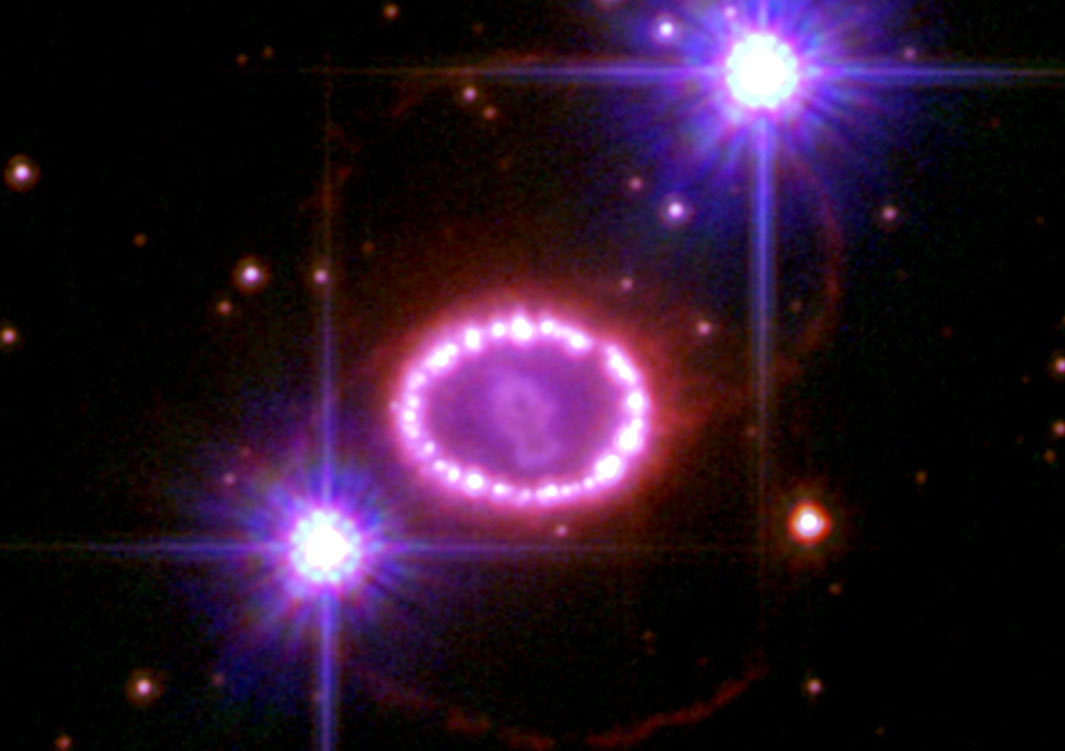
NASA / ESA / R. Kirshner (Harvard-Smithsonian Center for Astrophysics)
Spectra indicate that SN 2023ixf is a Type II supernova — the catastrophic destruction of an aging supergiant star. Massive suns fuse simpler elements into more complicated ones all the way up to iron. Each step liberates energy that pushes back against the force of gravity and stabilizes the star. But the buck stops at iron. Stable as a proverbial brick house, it takes crazy amounts of energy to fuse it — energy the star can't produce. No longer able to beat back gravity's crush, the star suddenly collapses. Material falling inward bounces off the shrinking core, creating shock waves that rebound outward and rip the supergiant apart in a titanic explosion. Type II events leave a neutron star or black hole in their wake — the tiny remnant of a life lived bigly.

Patrick Wiggins (University of Utah)
M101 is one of the most photographed galaxies in the sky, so astronomers immediately began looking for pre-discovery images that would record the early stages of the explosion as well as to identify a potential progenitor. Photos taken by amateur astronomers David Kennedy and Bronco Oostermeyer at 33, 18, and 9 hours prior to discovery show the supernova's brightness quickly rising from fainter than magnitude 21-22 to ~17.3 and ~15.3 magnitude, respectively. Meanwhile, a serendipitous time-lapse by a Chinese amateur captured the onset of the explosion on May 18th between 19:30 and 20:30 UT.
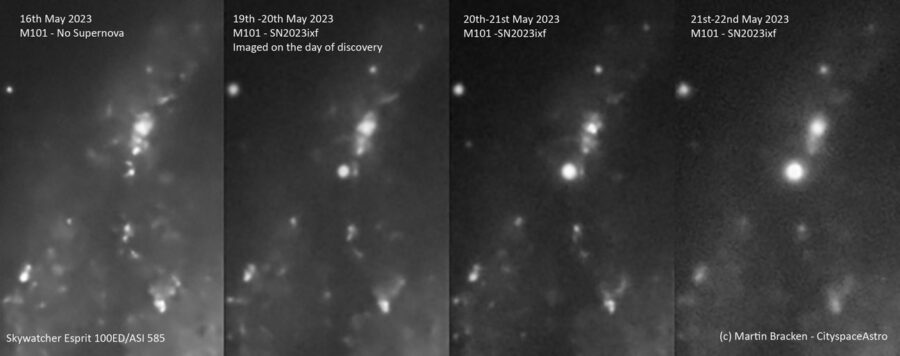
Martin Bracken
Although it's still early in the discovery phase, The Astronomer's Telegram posted an observation identifying a potential progenitor star — an approximately 15-solar-mass red supergiant ensconced in a circumstellar dust shell. Observers may remember SN 2011fe, the last bright supernova seen in M101. Discovered in August 2011, the Type Ia blast reached a peak magnitude of 9.9, easy quarry for a 60mm telescope. Will 2023ixf surpass it?
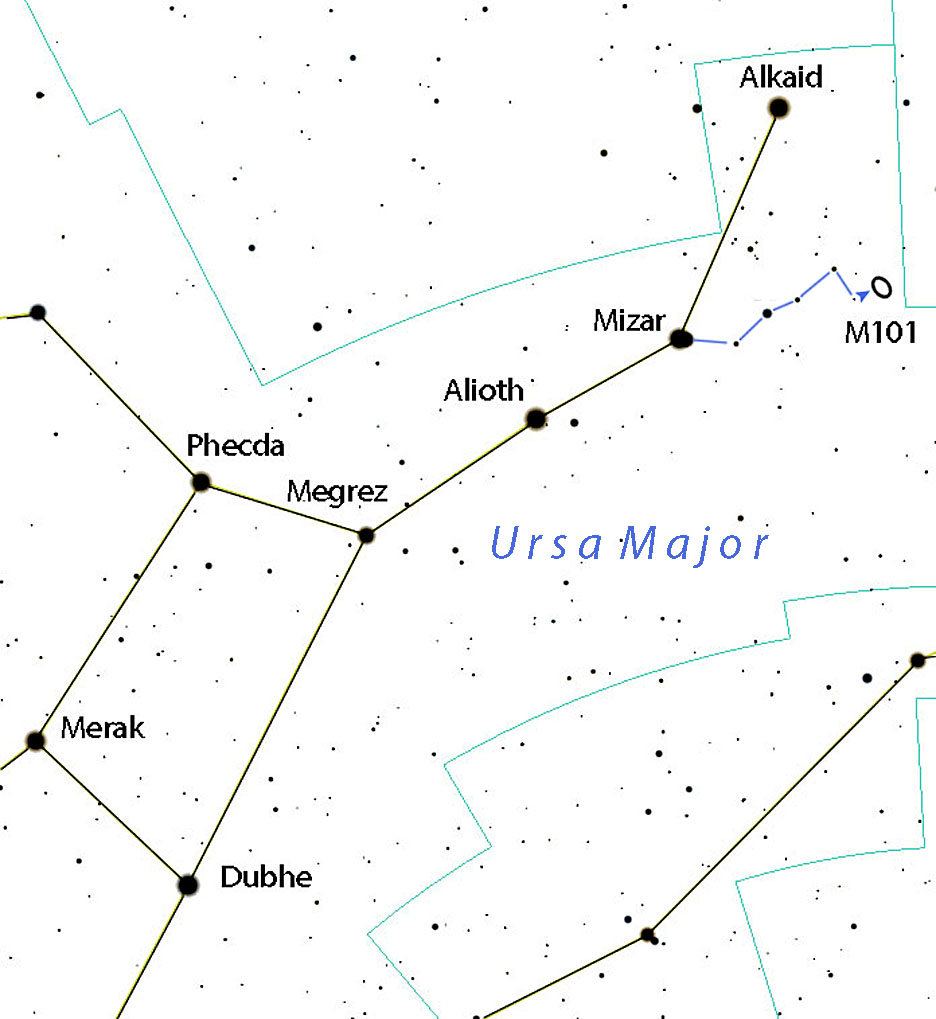
Stellarium
However bright the supernova may become, we're in for a wild ride. To find it, start at Mizar in the bend of the Big Dipper's handle and follow the star chain (a veritable yellow-brick road) leading from Mizar to M101. SN 2023ixf lies 3.8′ east and 2.2′ south of the galaxy's center. To make your own chart go to in-the-sky.org and search for M101. Any questions? Feel free to ask.

Courtesy of the AAVSO with additions by Bob King
I'm excited for the nights ahead and hope you are, too. I know a lot of us are dealing smoke from Canadian wildfires. To stay abreast of smoke trends NOAA offers a Fire and Smoke map and detailed forecast. For updated information and current images of the supernova visit David Bishop's Latest Supernovae.
 20
20









Comments
Ernie Ostuno
May 22, 2023 at 10:39 pm
The 2011 supernova in M101 was a nice one, visible for most of September and October in a 13-inch scope. I have been meaning to look for the brighter HII regions in that galaxy for a while so the excellent charts and drawings will be most useful the next few nights after the smoke disperses. Looks like a cold front finally clears things out on Wednesday. The RAP model 21 hour forecast for vertically integrated smoke can be found via this link:
https://rapidrefresh.noaa.gov/RAPsmoke/
You must be logged in to post a comment.
Bob KingPost Author
May 22, 2023 at 11:07 pm
Hi Ernie,
SN 2011fe was one of my faves. While I don't think the current SN will best it for magnitude it's exciting to see two supernovae in the same galaxy in just a few years. Milky Way are you listening?
Thanks for the excellent link!
You must be logged in to post a comment.
mxyzptlk
May 27, 2023 at 12:07 am
What's the prognosis for any civilizations in the vicinity of the supernova? Did they know it was coming? Did they have time to flee from the cataclysm they know was coming?
You must be logged in to post a comment.
Alan MacRobert
May 27, 2023 at 8:01 pm
If they're in the supernova's own solar system (light-hours from it), bye-bye. If they're as near to it as we are to Alpha Centauri (4.2 light-years), I'd be scared. Much farther, no big deal other than an unusual celestial event.
M101 is something like 60,000 light-years across.
You must be logged in to post a comment.
robin_astro
May 28, 2023 at 10:22 am
This was the core collapse event of a giant star so if they knew as much about astronomy as we do then yes they would have known about this star and had a good idea what was coming (Like we know will happen to Betelgeuse for example, though that is not close enough to cause us problems)
I did a quick rough calculation for someone on the "Cloudy Nights" forum and reckoned if it happened say 80 light years away (the distance to Regulus) this even would have been ~15x as bright as the full moon. Spectacular but not life threatening
You must be logged in to post a comment.
AstroDr.
May 23, 2023 at 7:22 am
I observed the new supernova (SN 2023ixf) in M101 this evening (10:02 UT on 5/23/2023) from the dark skies of West Molokai, Hawaii. Here is my observing report using only 70 mm of aperture (Televue Ranger 70 F/6.9 refractor). Transparency was 8/10 with some passing clouds and seeing was about 1". Temperature 74 degrees F.
Amazing view of this new supernova using such a small aperture! The SN was obvious and was the only bright stellar object within the outer halo of M101, located to the SE of the core. This corresponded perfectly with the position as plotted on the AAVSO finder chart found on the Sky & Telescope website. Although the AAVSO chart mostly only listed comparison stars between 11th to 14th magnitude, I could interpolate somewhat, and estimate the SN at between magnitude 10.7 and 11.0 as observed with the Edmund SuperPlössl (WF) 8mm, 60x eyepiece.
This supernova should be visible in big binoculars and apertures as small as 60 mm, so get out there and take a look before this spectacular object fades!
You must be logged in to post a comment.
Bob KingPost Author
May 23, 2023 at 11:29 am
Hi AstroDr.,
Glad you got to see it and thanks for sharing your observation. Despite all the forest fire smoke in my location I took the scope out for a look last night. It was immediately obvious, and as you described, the only bright "star" in the galaxy's halo. Using the 103 and 111 comp stars on the chart I estimated 11.0.
You must be logged in to post a comment.
Martian-Bachelor
May 23, 2023 at 5:16 pm
21 million ly corresponds to a distance modulus of m-M= 29.05, and so this is already abnormally bright by about a magnitude for a Type II SN, which typically max out at M = -17 to -17 1/4, corresponding to m=11.8 at best.
Keep us updated on what the spectra are telling us.
You must be logged in to post a comment.
Martian-Bachelor
May 23, 2023 at 5:48 pm
BTW - I looked at my historical SN database, and up thru 2015 there had been 3 in NGC 5457.
1909A was discovered at m=12.1 by Wolf and dubbed SS UMa.
1951H has m=17½ listed and has no other info except its position.
1970G was a Type II at m=11½ discovered by Lovas; there's an AJ paper with more info: vol 111, pg 2017.
I'm pretty sure these are the discovery magnitudes, not their maxima.
You must be logged in to post a comment.
Bob KingPost Author
May 23, 2023 at 9:18 pm
Martian-Bachelor,
Here is a link to a current spectrum made with the 4-m Mayall Telescope at Kitt Peak: https://www.wis-tns.org/sites/default/files/astronotes_files/1296/SN2023ixf_1.html at 3:19 UT on May 23. Note from TNS: "Emission lines previously seen in the Liverpool Telescope 5-19-23 spectrum have greatly decreased in strength and now only H-alpha, H-beta, and He II 4868 are seen clearly." Also, a recent ATEL describes a possible progenitor with an absolute magnitude of -4.66 (a good fit for a supergiant). More details here: https://www.astronomerstelegram.org/?read=16050
You must be logged in to post a comment.
Martian-Bachelor
May 24, 2023 at 3:07 pm
> "Emission lines previously seen in the Liverpool Telescope
> 5-19-23 spectrum have greatly decreased in strength and now
> only H-alpha, H-beta, and He II 4868 are seen clearly."
Yes, not only that but the spectrum you linked to looks nothing like a blackbody spectrum, which early Type II's typically do in the UV thru IR.
Plus, one would expect to see strong, broad H-alpha with an obvious P Cygni absorption on the blue side. I.e., that's no generic, early Type II SN spectrum. Thanks for the posting.
You must be logged in to post a comment.
robin_astro
May 24, 2023 at 3:31 pm
Actually the spectrum continuum is a good fit to a black body continuum. Here is my spectrum from 2023-05-21.9
https://britastro.org/observations/observation.php?id=20230522_192522_a81642b90b339b4b
It is early days though with type II spectra tending to be devoid of strong features at this point, developing strong P Cygni Balmer lines later. The early spectrum however matches SN 1998S which was a type n (ie it exploded into circumstellar material characterised by narrow features superimposed on broad lines) which might explain the relatively high luminosity for a type II
You must be logged in to post a comment.
Martian-Bachelor
May 25, 2023 at 12:15 am
That's very good. ~18,000°K is indeed an excellent fit, and your spectrum makes the emission lines seem more prominent. Is that C IV λ4658 that stands out?
I don't know about SN 1998S (Type II-n), but was looking today at SN 1979C, in the countdown spiral NGC 4321 (M100, in the Virgo Cluster), a Type II-L. ("L" for linear, as in the light curve.) According to Filippenko, "near maximum brightness the spectrum was very blue and almost featureless, with a slight bit of H-alpha emission. A week later, H-alpha emission was more easily discernable, and low-contrast P Cygni profiles of Na I, H-beta, and Fe II appeared."
BTW - SN 1979C was the second amateur discovery of a supernova (by Gus Johnson), using an 8" Newtonian.
You must be logged in to post a comment.
robin_astro
May 25, 2023 at 3:11 pm
The main spike in my spectrum there is He II 4686 I think but there could be C IV blended on the blue flank. In my spectrum last night
https://britastro.org/specdb/data_graph.php?obs_id=13783
The He component has now fallen away but there is still a broad blend there
You must be logged in to post a comment.
robin_astro
May 28, 2023 at 10:25 am
Here is the evolution of the spectrum over the past week
https://britastro.org/observations/observation.php?id=20230528_140227_583fe05370c08912
You must be logged in to post a comment.
Jen Willis
May 23, 2023 at 6:47 pm
This is exciting stuff! Still waiting for a clear enough night here locally to go hunting for the new supernova.
You must be logged in to post a comment.
Bob KingPost Author
May 23, 2023 at 9:20 pm
Hi Jen,
I saw it last night at (or near) peak. Amazing how boldly it stands out in the galaxy. I hope clear skies arrive soon!
You must be logged in to post a comment.
Todd
May 27, 2023 at 7:32 pm
Does anyone else see a number of faint objects that appear to move from upper right to lower left, most obviously on the left side of the animation when zoomed in? Are these artifacts or hot pixels? They all live by a similar and consistent amount between the frames of the animation - curious.
You must be logged in to post a comment.
bronco
May 30, 2023 at 4:17 pm
Thank you for mentioning me! It’s flattering to see my name show up in articles like these (and being asked to give some input for a BBC podcast).
You must be logged in to post a comment.
Bob KingPost Author
May 30, 2023 at 8:05 pm
Hi Bronco,
Glad to hear it! Thank you for sharing your data. It enriched the story!
You must be logged in to post a comment.
You must be logged in to post a comment.